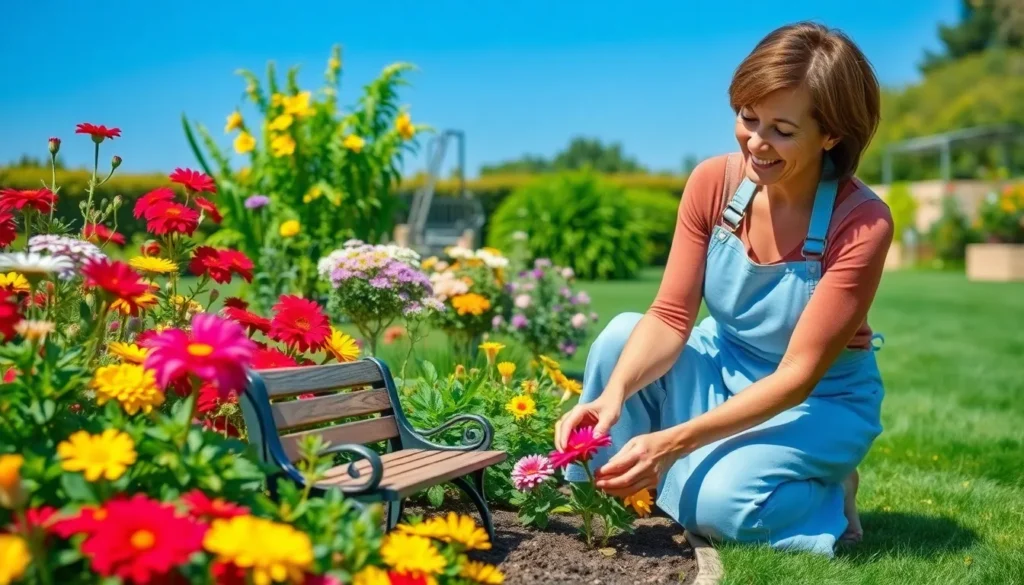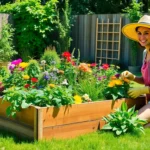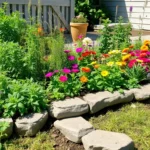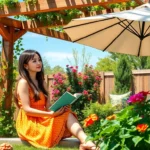We’ve all stood at our windows looking out at empty yards wondering how to transform those blank spaces into something magical. Creating an outdoor garden doesn’t have to feel overwhelming – it’s about finding the right ideas that match your space lifestyle and dreams.
Whether you’re working with a sprawling backyard or a cozy patio we’re here to help you discover garden ideas that’ll make your neighbors stop and stare. From low-maintenance succulent gardens to vibrant flower beds that bloom all season long there’s a perfect outdoor garden waiting to come to life in your space.
The best part? You don’t need a green thumb or a massive budget to get started. We’ll walk you through creative answers that work for beginners and seasoned gardeners alike turning your outdoor area into the retreat you’ve always wanted.
Create a Stunning Flower Garden Paradise
Flower gardens transform any outdoor space into a vibrant oasis that brings joy throughout the seasons. We’ll explore practical strategies to design a flourishing flower paradise that requires minimal effort while delivering maximum visual impact.
Choose Native Flowering Plants for Easy Maintenance
Native flowering plants thrive naturally in your local climate without extensive care or resources. We recommend selecting species that evolved in your region since they resist pests and diseases more effectively than exotic varieties.
Popular native options include:
- Black-eyed Susans for sunny areas
- Purple Coneflowers that attract butterflies
- Wild Bergamot with fragrant summer blooms
- Coral Bells offering colorful foliage year-round
Local extension offices provide comprehensive lists of native flowering plants exact to your growing zone. These plants typically need less water once established and adapt well to your soil conditions. Native species also support local wildlife including bees, butterflies, and beneficial insects that keep garden ecosystems balanced.
Design Colorful Seasonal Bloom Schedules
Seasonal bloom schedules ensure continuous color from early spring through late fall in your flower garden paradise. We suggest creating a timeline that maps when different flowers peak to avoid gaps in your display.
| Season | Early Bloomers | Mid-Season | Late Bloomers |
|---|---|---|---|
| Spring | Crocus, Daffodils | Tulips, Hyacinth | Lilac, Azaleas |
| Summer | Peonies, Iris | Roses, Delphiniums | Sunflowers, Zinnias |
| Fall | Asters, Mums | Sedum, Ornamental Kale | Japanese Anemone |
Planning your garden layout involves grouping plants with similar bloom times together for maximum impact. Early spring bulbs can occupy the same space as summer annuals since they finish blooming before warm-weather plants need the room. Succession planting extends flowering periods by staggering plantings of the same species every two weeks.
Incorporate Perennials for Long-Term Beauty
Perennials return year after year, making them cost-effective investments for your flower garden paradise. We recommend building your garden foundation with reliable perennials then adding annual flowers for extra pops of color.
Top-performing perennials for lasting beauty:
- Daylilies bloom repeatedly throughout summer
- Hostas provide lush foliage in shaded areas
- Phlox creates fragrant clusters of colorful flowers
- Ornamental grasses add texture and movement
Dividing perennials every 3-4 years keeps plants healthy while giving you free plants to expand your garden or share with neighbors. Many perennials spread naturally, filling in bare spots and creating fuller displays over time. Combining early, mid, and late-season perennials with different heights and textures creates ever-changing visual interest that evolves throughout the growing season.
Build a Productive Vegetable Garden Space

We’ll transform your outdoor space into a thriving vegetable garden that produces fresh crops throughout the growing season. Creating a productive vegetable garden requires strategic planning and smart design choices that maximize your harvest.
Plan Your Layout for Maximum Sun Exposure
Choose locations with 6 to 8 hours of direct sunlight daily since most vegetables require full sun conditions to reach their potential. We recommend positioning your garden beds where morning and afternoon light can reach all plants without obstruction from buildings or large trees.
Arrange rows in a north-south direction to ensure optimal light distribution across your entire garden space. This orientation allows sunlight to reach both sides of each row evenly throughout the day, preventing any plants from being permanently shaded.
Place taller plants on the north side of your beds to create a natural progression from tall to short crops. We suggest positioning corn, indeterminate tomatoes, and pole beans along the northern edge, followed by medium-height plants like peppers and bush tomatoes in the center, and finishing with low-growing crops like lettuce and radishes on the southern side.
Space plants according to their mature size rather than their current seedling dimensions to prevent overcrowding issues. Proper spacing ensures adequate air circulation, reduces disease pressure, and allows each plant to access sufficient nutrients and water.
Select High-Yield Crops for Small Spaces
Focus on compact varieties that produce maximum harvests in minimal square footage. We recommend radishes, lettuce, spinach, bush beans, and determinate tomatoes as excellent choices for space-efficient gardens since they mature quickly and don’t require extensive growing areas.
Use vertical supports for vining crops like cucumbers, peas, and pole beans to save valuable ground space. These climbing vegetables can produce substantial yields when grown upward on trellises, cages, or stakes, freeing up bed space for additional plantings.
Grow salad greens and herbs in containers to further optimize your garden’s productivity. Window boxes, hanging baskets, and small pots can house quick-growing crops like arugula, cilantro, and chives, allowing you to harvest fresh ingredients while maximizing your main garden beds for larger vegetables.
Keep beds productive with succession planting by sowing new seeds every 2-3 weeks for continuous harvests. This technique ensures you’ll have fresh crops ready throughout the growing season rather than experiencing gluts followed by shortages.
Carry out Companion Planting Strategies
Pair compatible plants to enhance growth and create natural pest deterrence systems within your garden beds. We’ve found that strategic plant combinations can improve soil health, attract beneficial insects, and increase overall garden productivity.
Plant tomatoes with basil to improve tomato flavor while naturally repelling harmful insects. This classic pairing demonstrates how companion planting creates mutually beneficial relationships between different crops in your garden space.
Combine carrots with onions to maximize root zone efficiency and deter common pests that target each crop individually. The onions’ strong scent masks the carrot smell that attracts carrot flies, while carrots help break up soil for the onions’ shallow root systems.
Group beans with corn to take advantage of natural nitrogen fixation and structural support. Beans add nitrogen to the soil that corn plants readily absorb, while corn stalks provide climbing structures for pole bean varieties.
Avoid planting family members together for extended periods to reduce disease transmission and pest buildup. We recommend rotating crops by family groups including cabbage, nightshade, pea, gourd, carrot, and amaranth families annually to maintain soil health and minimize plant-exact problems.
Design a Relaxing Herb Garden Sanctuary

Creating a dedicated herb garden sanctuary transforms your outdoor space into a functional retreat that engages all your senses. This specialized garden area combines practical cooking ingredients with therapeutic aromatherapy benefits.
Group Culinary Herbs by Usage Frequency
Frequently used herbs deserve prime real estate closest to your kitchen door for convenient daily harvesting. Basil and mint top this category since we reach for them multiple times per week for cooking and beverages. Position these high-traffic herbs within 10-15 steps of your back entrance.
Occasionally used herbs like rosemary and thyme work perfectly in the middle tier of your garden layout. We typically harvest these aromatic herbs once or twice weekly for roasts, marinades, and seasoning blends. Plant them 15-25 feet from your kitchen in raised beds or containers for easy access.
Rarely used herbs such as bay leaves and sage can occupy the furthest sections of your herb sanctuary. These specialty ingredients appear in our cooking perhaps once monthly but deserve garden space for their unique flavors and medicinal properties.
Create Aromatic Pathways with Fragrant Plants
Lavender creates stunning pathway borders that release calming fragrance with every gentle brush of clothing or skin. Plant these purple-flowered perennials 18 inches apart along walkway edges to form natural aromatherapy corridors. The essential oils intensify during warm afternoon sun, creating peak scent experiences.
Rosemary hedges serve dual purposes as pathway definitions and culinary ingredient sources. These evergreen herbs grow 2-4 feet tall and provide year-round structure while releasing pine-like fragrances when touched. Space individual plants 24 inches apart for proper air circulation.
Thyme groundcover between stepping stones releases lemony scents underfoot with each step. This low-growing herb tolerates moderate foot traffic and fills gaps beautifully between flagstones or pavers. Choose creeping varieties that spread naturally across pathway surfaces.
Establish a Tea Garden Section
Peppermint requires dedicated growing space since it spreads aggressively through underground runners. Plant this refreshing tea herb in large containers or install root barriers 12 inches deep to prevent garden takeover. We harvest fresh leaves throughout the growing season for hot and iced teas.
Lemon balm thrives in partial shade areas where other herbs might struggle. This citrus-scented member of the mint family produces abundant leaves perfect for calming evening teas. Position a comfortable bench nearby to create an instant meditation spot surrounded by therapeutic plants.
Chamomile flowers provide the classic sleepy-time tea ingredient that blooms continuously from spring through fall. These daisy-like flowers grow 12-18 inches tall and attract beneficial pollinators while producing harvestable blooms every few days. Dry the flowers immediately after picking for long-term tea storage.
Construct Vertical Gardens for Limited Space
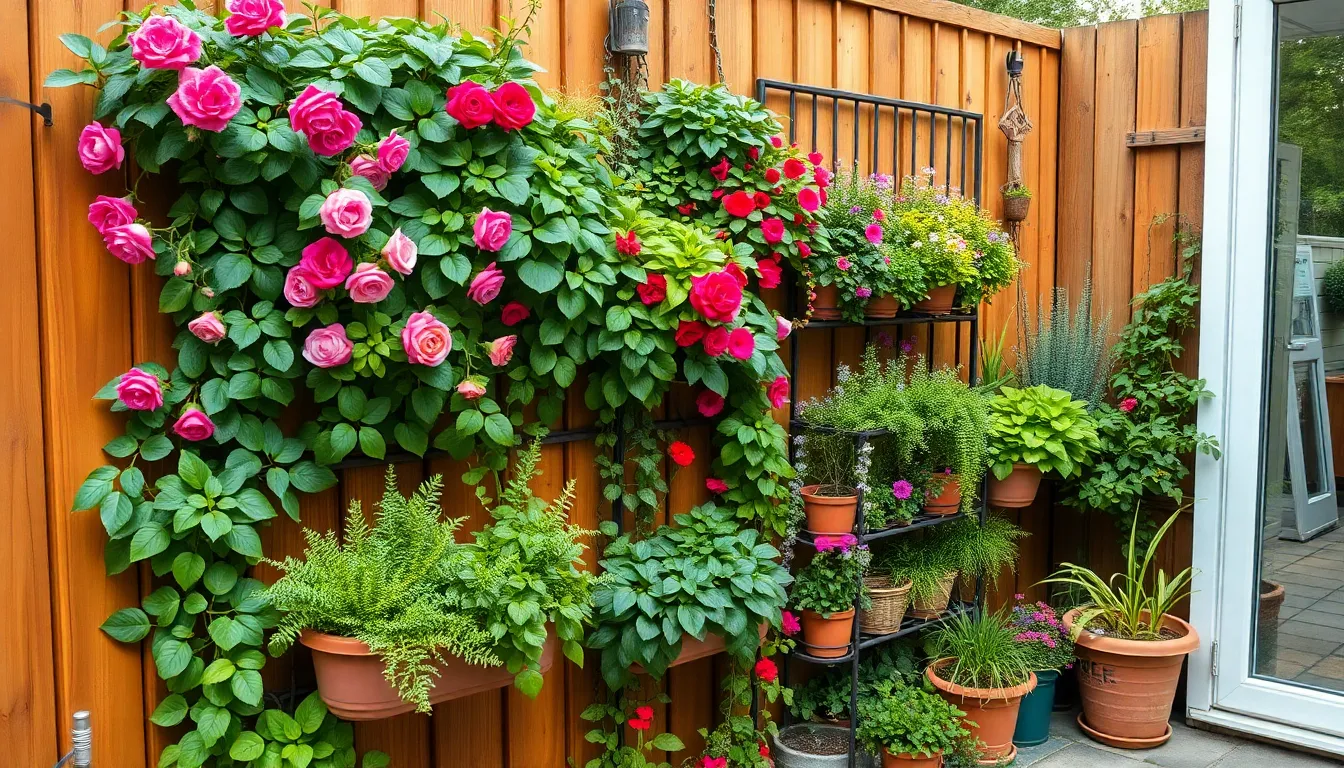
We transform cramped outdoor areas into lush green sanctuaries by utilizing vertical space efficiently. These vertical garden answers maximize our growing potential while creating stunning visual displays.
Install Living Walls and Trellises
Living walls provide exceptional insulation and aesthetic appeal by covering structures with climbing plants. We create these green barriers using modular systems that support various plant types, from flowering vines to edible crops. Trellises offer versatile support for climbing plants like roses, morning glories, and clematis, adding depth and dimension to our small gardens.
Installing trellis systems against walls or fences creates natural privacy screens while supporting productive plants. We position trellises to accommodate tomatoes, peas, and beans, which grow upward rather than outward. These structures transform blank vertical surfaces into productive growing areas that contribute both beauty and function to our outdoor spaces.
Use Hanging Planters and Containers
Hanging planters bring greenery to walls and fences without consuming valuable ground space. We select lightweight containers filled with ferns, alpines, or culinary herbs that thrive in elevated positions. These suspended gardens create cascading displays that draw the eye upward and make small areas feel larger.
Tiered containers display multiple plants within a compact footprint, maximizing our planting potential. We arrange these systems to showcase trailing varieties like petunias or ivy alongside upright herbs such as parsley and chives. Container gardens offer mobility and flexibility, allowing us to rearrange displays seasonally or relocate plants based on sunlight requirements.
Build Tiered Garden Structures
Tiered gardens create multi level growing areas that make small spaces appear larger and more visually interesting. We construct these stepped displays using raised beds or container arrangements that provide different elevations for diverse plant types. Each tier accommodates plants with varying height requirements, from ground cover succulents to medium height flowering plants.
Raised bed systems improve drainage while simplifying gardening tasks in confined areas. We build raised structures using weather resistant materials that complement our outdoor design aesthetic. These elevated gardens reduce bending and kneeling while creating distinct growing zones for different plant categories, from vegetables to ornamental flowers.
Establish a Wildlife-Friendly Garden Habitat

Creating a thriving network in our backyard transforms gardens into vibrant sanctuaries that support local wildlife year round. We can build diverse habitats by installing varied plantings including trees, shrubs, and ground cover to accommodate different species throughout the seasons.
Plant Pollinator-Attracting Flowers and Shrubs
Native flowering plants form the foundation of our pollinator-friendly garden spaces. We’ll select species that provide nectar and pollen throughout the growing season to attract bees, butterflies, and other beneficial insects. Staggered bloom times ensure continuous food sources from early spring through late fall.
Fruit trees like apple and plum offer early season blooms when pollinators emerge from winter dormancy. Mid season options include native wildflowers and perennials that peak during summer months. Late bloomers such as ivy provide crucial nutrition when other flowers fade in autumn.
Strategic placement creates maximum impact for our pollinator gardens. We position taller shrubs and trees as backdrop elements while shorter flowering plants fill foreground spaces. Grouping the same species in clusters of three to five plants creates visual appeal and makes nectar sources easier for pollinators to locate.
Create Bird-Friendly Feeding Stations
Multiple feeder types attract diverse bird species to our garden habitat. We install tube feeders filled with mixed seeds for smaller songbirds like finches and chickadees. Suet feeders provide high energy nutrition for woodpeckers and nuthatches during colder months.
Platform feeders accommodate ground feeding birds such as cardinals and juncos. Mesh feeders work perfectly for nyjer seeds that attract goldfinches and siskins. We position all feeders near shrubs or trees to provide shelter and quick escape routes for visiting birds.
Regular maintenance keeps our feeding stations healthy and productive. We clean feeders every two weeks with a diluted bleach solution to prevent disease transmission. Fresh water sources complement feeding stations and encourage birds to linger in our garden spaces.
Design Natural Water Features
Water elements create essential habitat components that attract wildlife beyond just birds. We incorporate shallow pools, birdbaths, or small ponds to provide drinking and bathing opportunities for various species. Moving water features like fountains or drippers attract more wildlife while deterring mosquito breeding.
Strategic placement near existing cover maximizes usage of our water features. We position them close to shrubs or trees so animals can safely approach and retreat. Shallow edges with gradual slopes allow easy entry and exit for creatures of different sizes.
Natural materials enhance the aesthetic appeal of our water features. We use stones, pebbles, and native plants around edges to create seamless integration with surrounding garden elements. Multiple water sources at varying heights accommodate different wildlife preferences and create backup options during maintenance periods.
Develop Themed Garden Rooms and Zones

We can transform our outdoor spaces into distinct areas that serve different purposes and create unique experiences throughout our gardens. Building separate themed zones allows us to maximize functionality while adding visual interest and creating natural transitions between different garden styles.
Create a Mediterranean-Style Garden Area
Mediterranean gardens bring warmth and drought tolerant beauty to our outdoor spaces with their signature sun loving plants and rustic materials. Drought tolerant plants like lavender, rosemary, and olive trees thrive in these conditions while requiring minimal water maintenance once established. We’ll want to position these plants in the sunniest areas of our garden where they can soak up maximum sunlight throughout the day.
Terracotta pots add authentic Mediterranean charm while providing flexibility for seasonal arrangements and plant mobility. These clay containers work particularly well for herbs like basil and oregano that we can move closer to our kitchen during peak growing season. Stone pathways using natural materials create walking surfaces that complement the rustic aesthetic while providing practical access through the garden.
Water features such as small fountains or decorative birdbaths introduce soothing sounds while attracting beneficial wildlife to our Mediterranean zone. These elements work especially well when positioned near seating areas where we can enjoy the peaceful ambiance during evening relaxation.
Design a Japanese Zen Garden Space
Japanese Zen gardens emphasize simplicity and mindfulness through carefully chosen natural elements and minimalist design principles. Gravel or sand serves as the foundation for these contemplative spaces, with raked patterns creating visual texture and meditative focal points. We can use fine gravel around larger stones to create flowing patterns that represent water movement.
Bonsai trees bring living art into our Zen garden while requiring dedicated care and pruning to maintain their sculptural forms. These miniature trees work best when displayed on weathered wooden stands or natural stone platforms that elevate them as garden focal points. Small Japanese maples and juniper varieties adapt well to container growing in most climates.
Natural elements like carefully placed stones, bamboo screens, and small water basins complete the serene atmosphere we’re creating. Stone lanterns provide gentle lighting for evening meditation while maintaining the authentic aesthetic of traditional Japanese garden design.
Establish a Cottage Garden Corner
Cottage gardens overflow with colorful blooms and create charming, informal spaces that combine beauty with practical growing. Flowering perennials like roses, peonies, and daisies provide reliable color year after year while establishing the romantic foundation of our cottage garden design. We should plant these in generous clusters rather than single specimens to achieve the abundant look that defines cottage garden style.
Mixed plantings combine flowers, herbs, and vegetables in delightful combinations that maximize both visual appeal and garden productivity. Nasturtiums climb through tomato plants while marigolds protect vegetable crops from harmful insects, creating beneficial partnerships throughout our cottage garden. This approach allows us to harvest fresh ingredients while enjoying continuous blooms.
Natural fencing using wooden picket barriers or established hedges creates cozy boundaries that define our cottage garden space without blocking views completely. Climbing roses and honeysuckle vines can scramble over these structures, adding vertical interest and sweet fragrances that enhance our cottage garden experience.
Install Hardscaping Elements for Structure
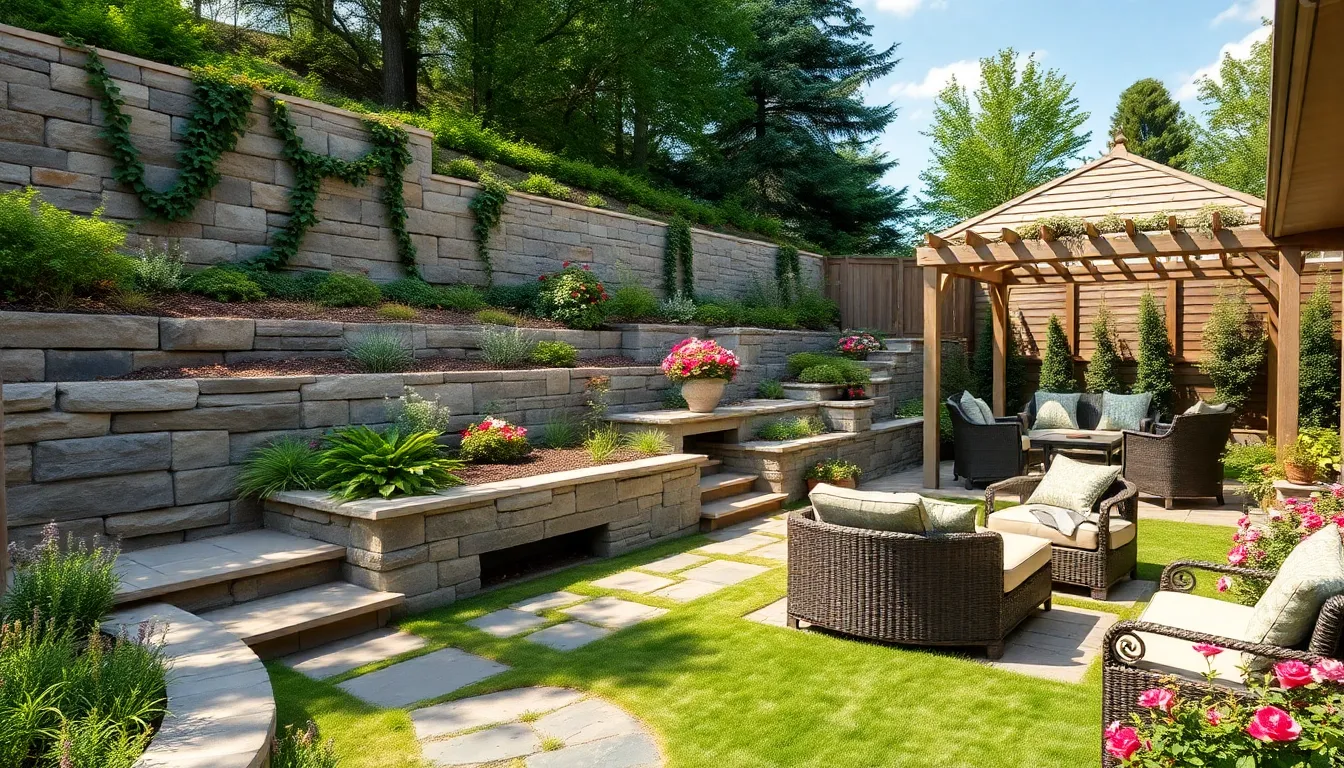
Hardscaping elements provide the backbone that transforms our garden spaces from simple plant collections into cohesive outdoor living areas. These structural features create defined zones while adding year-round visual interest that complements our seasonal plantings.
Add Decorative Pathways and Walkways
Stone pavers create visually appealing paths that guide visitors through our garden spaces while protecting grass and plants from foot traffic. We can border these pathways with shrubs and ornamental grasses to achieve a natural, integrated look that connects different garden areas seamlessly.
Gravel pathways offer a rustic alternative that works particularly well in informal garden settings. These cost-effective walkways provide excellent drainage while creating pleasant crunching sounds underfoot. We’ll want to edge gravel paths with plants and flowers to soften the hardscape and prevent gravel from spreading into planting beds.
Curved pathways encourage slower movement through the garden, allowing visitors to appreciate individual plants and design elements along the way. Straight paths work better for high-traffic areas where we need efficient movement between functional spaces like vegetable gardens and outdoor kitchens.
Build Retaining Walls and Raised Beds
Tiered gardening beds created with retaining walls maximize planting space on sloped properties while preventing soil erosion. These structures work especially well for homes built on hills, where traditional flat gardens aren’t practical. We can construct these walls using natural stone, concrete blocks, or timber depending on our budget and aesthetic preferences.
Attached trellises provide dual functionality when we mount them on retaining walls. These vertical supports create privacy screens while offering climbing space for flowering vines and food plants. Popular climbing options include clematis, roses, and edible plants like pole beans and cucumbers.
Raised garden beds improve drainage and soil quality while reducing the physical strain of gardening. We can build these structures at comfortable heights for easier planting, weeding, and harvesting. Materials like cedar, composite lumber, or stone blocks create durable raised bed systems that last for decades.
Incorporate Outdoor Seating Areas
Bench seating made from stone, wood, or metal creates inviting rest spots throughout our garden spaces. We should position these benches to take advantage of scenic views, fragrant plantings, or peaceful water features. Built-in benches along retaining walls maximize seating while conserving space in smaller gardens.
Sectional seating arranged around fire pits transforms our gardens into year-round entertainment spaces. These comfortable seating arrangements encourage longer outdoor stays and create cozy gathering spots for family and friends. We can enhance these areas with weather-resistant cushions and side tables for added functionality.
Pergolas and gazebos provide sheltered seating areas that offer protection from sun and light rain. These substantial structures create outdoor rooms that extend our living space while supporting climbing plants for natural shade and beauty.
Implement Water Features for Tranquility

Water features transform your garden into a peaceful sanctuary while adding visual appeal and natural sounds that mask urban noise. These additions create focal points that enhance both the aesthetic and therapeutic value of your outdoor space.
Install Fountains and Water Gardens
Fountains offer versatile options ranging from compact tabletop models to grand centerpieces that serve as stunning focal points. Tiered fountains create cascading water sounds that promote relaxation, while wall-mounted versions save valuable ground space in smaller gardens. Freestanding fountains can be positioned strategically to create visual interest and serve as conversation pieces during outdoor gatherings.
Water gardens in wooden barrels provide an affordable entry point for beginners, requiring minimal space while offering maximum impact. Natural stone waterfalls blend seamlessly with existing landscaping, creating the illusion of naturally occurring water features. Pondless waterfalls work exceptionally well in compact spaces, delivering the soothing sounds of flowing water without the maintenance requirements of traditional pond systems.
Koi ponds combine aquatic life with beautiful water displays, creating ever-changing environments that change throughout the seasons. These living water features require careful planning but reward you with peaceful viewing opportunities and the gentle sounds of fish activity. Decorative fountains serve dual purposes as both functional water features and artistic garden sculptures.
Create Rain Gardens for Sustainability
Rain gardens capture and filter stormwater runoff while reducing your environmental footprint and water bills. These sustainable features use plants that thrive in wet conditions, creating natural filtration systems that protect local waterways from pollution. Native plants adapted to periodic flooding establish easily and require minimal maintenance once established.
Rainwater harvesting systems complement rain gardens by collecting precipitation for later irrigation use. These systems reduce municipal water consumption while providing chlorine-free water that plants prefer. Storage capacity can range from simple rain barrels to elaborate underground cisterns, depending on your garden’s size and water needs.
Design considerations include proper placement in natural drainage areas and selecting appropriate plant varieties for your climate zone. Plants like cattails, cardinal flower, and native sedges excel in rain garden environments while providing habitat for beneficial wildlife.
Build Pond Systems with Aquatic Plants
Pond systems create complete aquatic ecosystems that support diverse plant and animal life while serving as tranquil garden centerpieces. Aquatic plants like water lilies and cattails naturally purify water by absorbing excess nutrients and producing oxygen. These biological filters reduce algae growth while creating balanced environments that require less chemical intervention.
Plant selection varies by water depth, with floating plants, submerged oxygenators, and marginal plants each serving exact ecological functions. Water lilies provide surface coverage that reduces algae growth, while submerged plants like hornwort oxygenate the water column. Marginal plants such as pickerel rush and arrowhead soften pond edges while providing wildlife habitat.
Regular maintenance includes removing decomposing plant material, monitoring water quality, and seasonal plant care to ensure healthy pond ecosystems. Proper circulation systems and biological filtration support both plant health and water clarity throughout the growing season.
Design Seasonal Interest Gardens
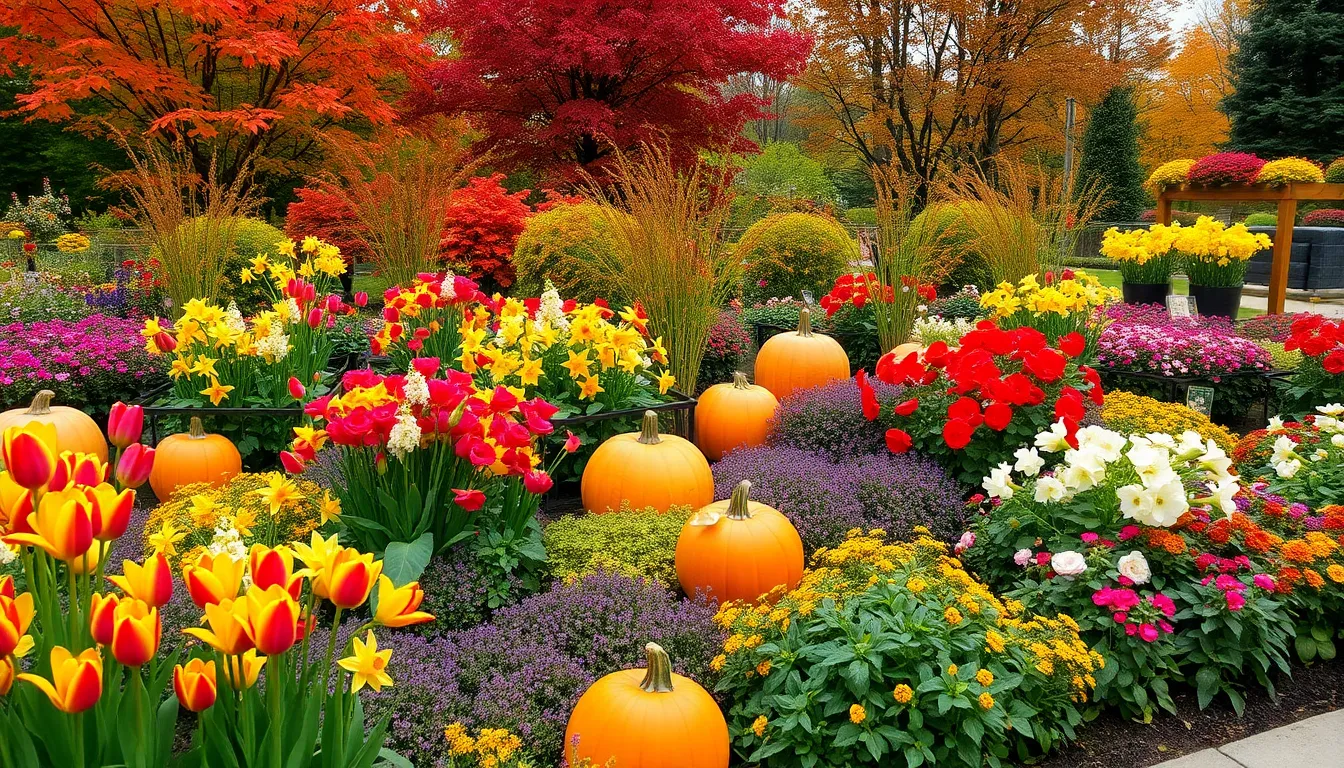
Building upon our themed garden concepts, we can create ever-changing outdoor spaces that captivate visitors throughout the entire year. Seasonal gardens transform ordinary landscapes into ever-changing displays that showcase nature’s remarkable diversity.
Plan Spring Bulb Displays
Plant spring bulbs in fall to guarantee spectacular early-season color after winter’s dormant months. Tulips, daffodils, and hyacinths create vibrant displays when strategically planted before the first frost arrives. We recommend grouping bulbs in clusters of 7-15 specimens for maximum visual impact rather than scattering them individually.
Layer different bulb varieties with varying bloom times to extend the spring flowering season. Early bloomers like crocuses emerge first, followed by daffodils in mid-spring, then tulips for the grand finale. This succession planting technique ensures continuous color from February through May in most temperate climates.
Incorporate early-blooming perennials like violas and primroses alongside bulb plantings for enhanced texture and color depth. These hardy plants fill gaps between bulb clusters and provide consistent foliage after bulbs finish flowering. Position them in front of taller bulb varieties to create layered spring compositions.
Create Summer Color Explosions
Fill gardens with vibrant annuals like impatiens and petunias that deliver non-stop color from late spring through first frost. These reliable performers thrive in containers, borders, and mass plantings while requiring minimal maintenance beyond regular watering. We suggest combining contrasting colors like purple petunias with yellow marigolds for striking visual combinations.
Add perennial powerhouses including roses and lilies that return year after year with spectacular summer blooms. Roses provide continuous flowering when deadheaded regularly, while lilies offer dramatic height and fragrance during peak summer months. Plant them in groups of three or five for balanced garden compositions.
Install hanging baskets filled with trailing plants like ivy and begonias to add vertical interest and whimsical charm to summer displays. These elevated plantings draw the eye upward and create cascading waterfalls of color on porches, pergolas, and arbors. Choose heat-tolerant varieties that maintain their appearance during hot summer weather.
Establish Fall Foliage Attractions
Select trees and shrubs with outstanding autumn foliage like maples and oaks that transform ordinary landscapes into spectacular color displays. Japanese maples offer brilliant reds and oranges, while sugar maples provide classic golden-yellow fall colors. Plant them as focal points or specimen trees where their seasonal transformation becomes the garden’s centerpiece.
Include berry-bearing plants such as elderberry shrubs and crabapple trees that provide both visual interest and wildlife food sources during autumn months. These plants extend seasonal appeal beyond foliage color while supporting local bird populations preparing for winter migration. Position them near seating areas where we can observe visiting wildlife.
Enhance displays with decorative elements like pumpkins and gourds that complement natural fall foliage colors. These seasonal additions create festive autumn vignettes when arranged around garden beds, pathways, and entrance areas. Replace them periodically throughout the season to maintain fresh, inviting appearances that celebrate harvest time traditions.
Add Lighting for Evening Garden Enjoyment

Transform your outdoor space into an enchanting evening retreat with strategic lighting choices. Well-planned garden illumination extends your enjoyment hours while creating magical atmospheric effects that enhance your industry’s natural beauty.
Install Solar-Powered Pathway Lights
Solar-powered lights offer an eco-friendly and cost-effective solution for illuminating garden walkways without electricity costs. These sustainable fixtures automatically charge during daylight hours and provide gentle illumination throughout the evening, creating safe passage while highlighting your garden’s pathways.
We recommend positioning solar pathway lights every 6 to 8 feet along walkways to ensure adequate coverage and visual continuity. Choose fixtures with adjustable brightness settings to customize the intensity based on your exact lighting needs and garden size.
Modern solar technology delivers reliable performance even during cloudy weather, with most quality units providing 8 to 10 hours of continuous illumination. Place these lights in areas that receive direct sunlight for at least 6 hours daily to maximize their charging potential and nighttime performance.
Create Ambient String Light Displays
String lights instantly transform ordinary garden spaces into magical outdoor rooms perfect for evening gatherings and relaxation. Drape these versatile fixtures over trees, pergolas, or along walkways to create cozy and inviting atmospheres that extend your garden’s usability into the night.
Wrap string lights around tree trunks, deck railings, or trellises to establish unique focal points that draw the eye and create visual interest. Edison bulb varieties and mercury ball string lights offer distinctive character that complements both modern and traditional garden designs.
We suggest using warm white LED string lights for energy efficiency and longevity, as they consume up to 80% less energy than traditional incandescent bulbs. Layer different heights and patterns to create depth and dimension, ensuring even light distribution throughout your outdoor entertainment areas.
Highlight Feature Plants with Spotlights
Strategic spotlight placement draws attention to your garden’s most spectacular features, including prized plants, sculptures, or architectural elements. These focused lighting answers create dramatic visual effects during evening hours while showcasing the unique characteristics of exact garden elements.
Position spotlights at ground level angling upward to create stunning silhouettes and highlight the natural textures of tree bark, interesting plant forms, or decorative garden structures. LED spotlights with adjustable beam angles allow you to customize the coverage area and intensity for each featured element.
We recommend using warm white or soft white spotlights to maintain natural color representation of plants and flowers during nighttime viewing. Install these fixtures on timer systems or motion sensors to optimize energy usage while ensuring your garden’s key features remain beautifully illuminated throughout the evening hours.
Conclusion
We’ve explored countless ways to transform your outdoor space into a thriving garden sanctuary that reflects your personal style and meets your practical needs. Whether you’re drawn to productive vegetable plots vibrant flower displays or peaceful herb gardens there’s an approach that’ll work perfectly for your space and experience level.
Remember that successful gardens evolve over time so don’t feel pressured to carry out every idea at once. Start with one or two concepts that excite you most and gradually expand your outdoor haven as you gain confidence and discover what works best in your exact environment.
Your dream garden is within reach regardless of your space size or budget constraints. With thoughtful planning strategic design choices and a willingness to experiment you’ll soon have an outdoor retreat that brings joy year-round and becomes a source of pride for years to come.
Frequently Asked Questions
What types of plants work best for beginners starting their first garden?
Native flowering plants are ideal for beginners because they thrive in local climates and require minimal maintenance. They’re naturally resistant to pests and diseases, making them more forgiving for new gardeners. Consider starting with easy-to-grow options like marigolds, zinnias, or regional wildflowers. Consult your local extension office for specific recommendations based on your area’s climate and soil conditions.
How can I create a garden in a small outdoor space like a patio or balcony?
Maximize small spaces with vertical gardening techniques like living walls, trellises, and hanging planters. Use tiered containers and multi-level structures to create growing areas without taking up ground space. Consider compact vegetable varieties and herbs that don’t require extensive root systems. Vertical supports for vining crops and cascading displays can transform even the smallest patio into a lush garden retreat.
What vegetables should I grow for the best harvest in limited space?
Focus on high-yield, compact varieties like cherry tomatoes, lettuce, radishes, and herbs. Use succession planting to ensure continuous harvests throughout the season. Implement companion planting strategies, such as pairing tomatoes with basil or carrots with onions, to maximize space efficiency and improve plant health. Vertical growing methods work well for beans, peas, and cucumber varieties.
How do I ensure my flower garden has color throughout the growing season?
Plan a seasonal bloom schedule by selecting early, mid, and late-season bloomers. Group plants with similar bloom times for maximum visual impact. Incorporate perennials that return yearly and can be divided to expand your garden. Layer different varieties of spring bulbs in fall, use vibrant summer annuals, and include plants with stunning fall foliage to maintain year-round interest.
What are the benefits of creating a wildlife-friendly garden?
Wildlife-friendly gardens support local ecosystems by providing food sources for pollinators and birds year-round. Plant diverse flowers and shrubs with staggered bloom times to ensure continuous nectar availability. Add bird feeding stations and natural water features like shallow pools or birdbaths. These elements attract beneficial insects, birds, and other wildlife while creating a more balanced and thriving garden environment.
How can I incorporate water features into my garden design?
Water features add tranquility and visual appeal to any garden space. Consider fountains, small ponds, or birdbaths as focal points that provide soothing sounds. Rain gardens capture stormwater runoff and promote sustainability. Position water features strategically near existing cover and use natural materials for seamless garden integration. Even simple shallow pools can attract wildlife and enhance your garden’s aesthetic.
What hardscaping elements should I consider for my garden structure?
Essential hardscaping includes decorative pathways using stone pavers or gravel, which can be curved for visual interest or straight for formal designs. Retaining walls and raised beds maximize planting space and improve drainage. Incorporate outdoor seating areas like benches or pergolas to create inviting relaxation spaces. These structural elements provide year-round visual interest and improve garden functionality.
How can I create different themed areas within my garden?
Design distinct garden rooms with specific themes like Mediterranean areas featuring drought-tolerant plants and terracotta pots, Japanese Zen gardens emphasizing simplicity and natural elements, or cottage garden corners with colorful mixed plantings. Use natural fencing, different plant groupings, and varying hardscaping materials to define each themed zone while maintaining overall garden cohesion and maximizing both beauty and functionality.
What lighting options work best for evening garden enjoyment?
Solar-powered pathway lights provide eco-friendly illumination and should be placed every 6-8 feet for optimal coverage. String lights create ambient lighting perfect for gatherings and relaxation areas. Use spotlights to highlight feature plants and create dramatic visual effects. Strategic lighting placement transforms gardens into enchanting evening retreats while being energy-efficient and easy to install without extensive electrical work.

